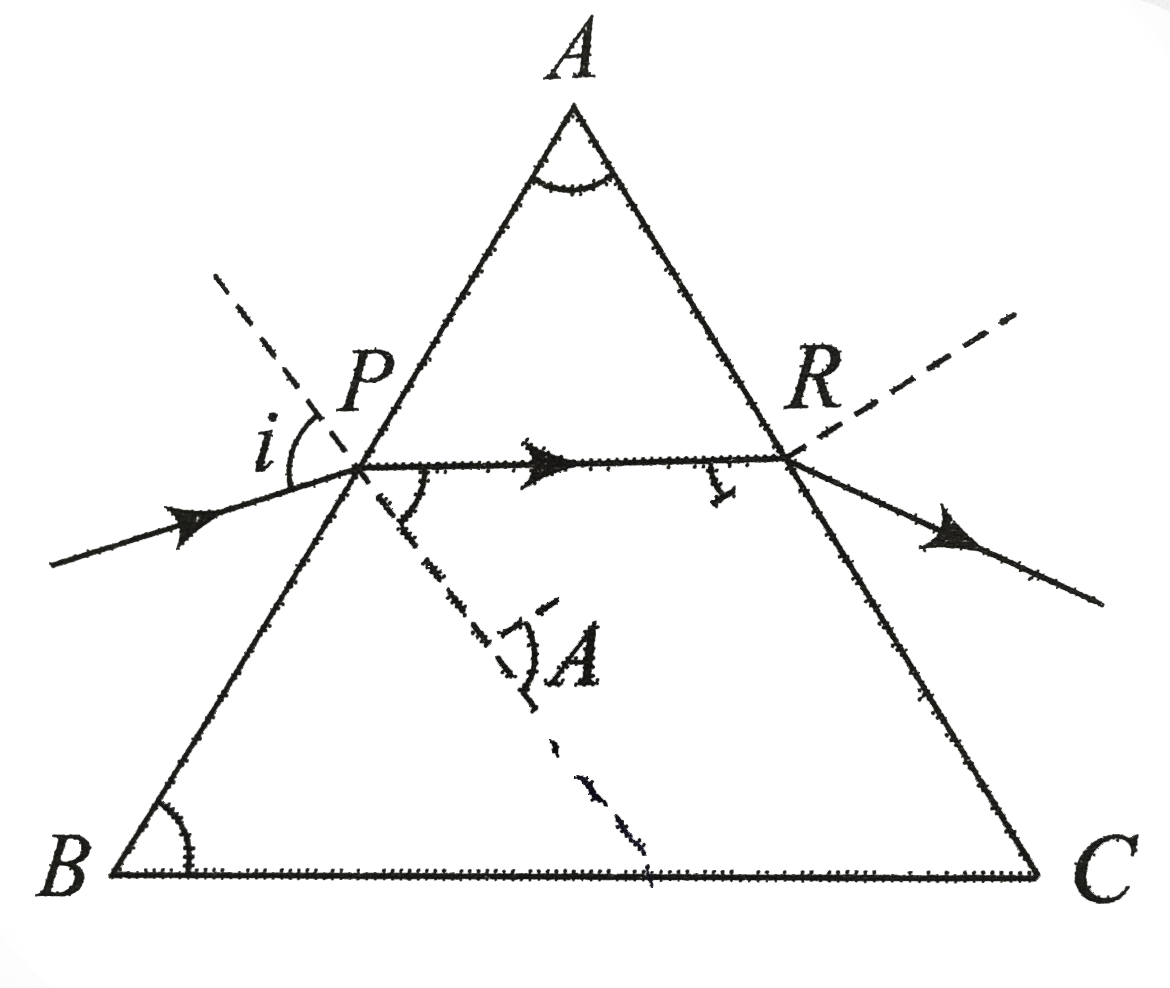A ray of light undergoes deviation of 30∘ when incident on an equilateral prism of refractive index √2. The angle made by the ray inside the prism with the base of the prism is
15∘
0∘
45∘
30∘
The correct Answer is:B
To solve the problem, we need to find the angle made by the ray inside the prism with the base of the prism when a ray of light undergoes a deviation of 30∘ while passing through an equilateral prism with a refractive index of √2.
1. Identify Given Values:
- Angle of deviation (δ) = 30∘
- Refractive index (μ) = √2
- Angle of the prism (A) = 60∘ (since it is an equilateral prism)
2. Use the Formula for Refractive Index:
The relationship between the refractive index, angle of prism, and angle of deviation can be expressed as:
μ=sin(A+δ2)sin(A2)
3. Substitute the Known Values:
Substitute A=60∘ and δ=30∘ into the formula:
√2=sin(60∘+30∘2)sin(60∘2)
This simplifies to:
√2=sin(45∘)sin(30∘)
4. Calculate the Sine Values:
- sin(45∘)=1√2
- sin(30∘)=12
5. Substitute the Sine Values:
Substitute the sine values back into the equation:
√2=1√212
Simplifying this gives:
√2=1√2⋅2=2√2=√2
This confirms that our values are consistent.
6. Determine the Angle Inside the Prism:
At minimum deviation, the ray travels parallel to the base of the prism. Therefore, the angle made by the ray inside the prism with the base of the prism is:
Angle with the base=0∘
Final Answer:
The angle made by the ray inside the prism with the base of the prism is 0∘.
- Angle of deviation (δ) = 30∘
- Refractive index (μ) = √2
- Angle of the prism (A) = 60∘ (since it is an equilateral prism)
The relationship between the refractive index, angle of prism, and angle of deviation can be expressed as:
μ=sin(A+δ2)sin(A2)
Substitute A=60∘ and δ=30∘ into the formula:
√2=sin(60∘+30∘2)sin(60∘2)
This simplifies to:
√2=sin(45∘)sin(30∘)
- sin(45∘)=1√2
- sin(30∘)=12
Substitute the sine values back into the equation:
√2=1√212
Simplifying this gives:
√2=1√2⋅2=2√2=√2
This confirms that our values are consistent.
At minimum deviation, the ray travels parallel to the base of the prism. Therefore, the angle made by the ray inside the prism with the base of the prism is:
Angle with the base=0∘
The angle made by the ray inside the prism with the base of the prism is 0∘.
Topper's Solved these Questions
- RAY OPTICSBOOK - DC PANDEY ENGLISHCHAPTER - RAY OPTICSEXERCISE - A. Only one option is correct (JEE Advance)
73 Videos
- RAY OPTICSBOOK - DC PANDEY ENGLISHCHAPTER - RAY OPTICSEXERCISE - B. More than one option is correct
20 Videos
- PROPERTIES OF MATTERBOOK - DC PANDEY ENGLISHCHAPTER - PROPERTIES OF MATTEREXERCISE - Integer
8 Videos
- ROTATIONBOOK - DC PANDEY ENGLISHCHAPTER - ROTATIONEXERCISE - (C) Chapter Exercises
39 Videos
Similar Questions
A ray of light undergoes deviation of 30∘ when incident on an equilateral prism of refractive index √2. what is the angle subtended by the ray inside the prism with the base of the prism?
View SolutionA ray of light undergoes a deviation of 30∘ when incident on an equilateral prism of refractive index √2.
What is the angle subtended by the ray inside the prism with the base of the prism?

View SolutionA ray of light suffers a minimum deviation when incident on equilateral prism of refractive index √2 The angle of deviation is
View SolutionWhat is the angle of incidence for an equilateral prism of refractive index √3 so that the ray si parallel to the base inside the prism?
View SolutionA light ray is normally incident onone face of equilateral glass prism of refractive index √2. The deviation of light ray is
View SolutionA ray of light is incident normally on one face of an equilateral prism of refractive index 1.5. The angle of deviation is: (Given sin−1.23=42∘)
View SolutionIf the angle of minimum deviation is of 60∘ for an equilateral prism , then the refractive index of the material of the prism is
View SolutionThe angle of incidance for an equilateral prism is 60∘. What should be the refractive index of prism so that the ray is parallel to the base inside the prism ?
View SolutionWhen a ray of light is incident normally on one refracting surface of an equilateral prism (Refractive index of the material of the prism =1.5
View SolutionA ray of light is incident normally on one of the faces of a prism of apex angle 30 degree and refractive index √2. The angle of deviation of the ray in degrees is
View Solution
